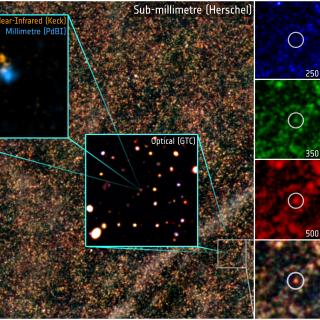Bibcode
Bendo, G. J.; Urquhart, S. A.; Serjeant, S.; Bakx, T.; Hagimoto, M.; Cox, P.; Neri, R.; Lehnert, M. D.; Dannerbauer, H.; Amvrosiadis, A.; Andreani, P.; Baker, A. J.; Beelen, A.; Berta, S.; Borsato, E.; Buat, V.; Butler, K. M.; Cooray, A.; De Zotti, G.; Dunne, L.; Dye, S.; Eales, S.; Enia, A.; Fan, L.; Gavazzi, R.; González-Nuevo, J.; Harris, A. I.; Herrera, C. N.; Hughes, D. H.; Ismail, D.; Jones, B. M.; Kohno, K.; Krips, M.; Lagache, G.; Marchetti, L.; Massardi, M.; Messias, H.; Negrello, M.; Omont, A.; Pérez-Fournon, I.; Riechers, D. A.; Scott, D.; Smith, M. W. L.; Stanley, F.; Tamura, Y.; Temi, P.; van der Werf, P.; Verma, A.; Vlahakis, C.; Weiß, A.; Yang, C.; Young, A. J.
Referencia bibliográfica
Monthly Notices of the Royal Astronomical Society
Fecha de publicación:
6
2023
Número de citas
30
Número de citas referidas
24
Descripción
We present 101- and 151-GHz ALMA continuum images for 85 fields selected from Herschel observations that have 500-μm flux densities >80 mJy and 250-500-μm colours consistent with z > 2, most of which are expected to be gravitationally lensed or hyperluminous infrared galaxies. Approximately half of the Herschel 500-μm sources were resolved into multiple ALMA sources, but 11 of the 15 brightest 500-μm Herschel sources correspond to individual ALMA sources. For the 37 fields containing either a single source with a spectroscopic redshift or two sources with the same spectroscopic redshift, we examined the colour temperatures and dust emissivity indices. The colour temperatures only vary weakly with redshift and are statistically consistent with no redshift-dependent temperature variations, which generally corresponds to results from other samples selected in far-infrared, submillimetre, or millimetre bands but not to results from samples selected in optical or near-infrared bands. The dust emissivity indices, with very few exceptions, are largely consistent with a value of 2. We also compared spectroscopic redshifts to photometric redshifts based on spectral energy distribution templates designed for infrared-bright high-redshift galaxies. While the templates systematically underestimate the redshifts by ~15 per cent, the inclusion of ALMA data decreases the scatter in the predicted redshifts by a factor of ~2, illustrating the potential usefulness of these millimetre data for estimating photometric redshifts.
Proyectos relacionados

Formación y Evolución de Galaxias: Observaciones Infrarrojas y en otras Longitudes de Onda
Este grupo desarrolla varios proyectos extragalácticos en diferentes rangos del espectro electromagnético utilizando satélites y telescopios en tierra para estudiar la evolución cosmológica de las galaxias y el origen de la actividad nuclear en galaxias activas. En el aspecto instrumental, el grupo forma parte del consorcio internacional que ha
Ismael
Pérez Fournon

Gas Molecular y Polvo en Galacias através del Tiempo Cósmico
Dos cuestiones fundamentales en la Astrofísica son la conversión de gas molecuar en estrellas y cómo este proceso físico depende del entorno en todas las escalas, desde sistemas planetarios, cúmulos estelares, galaxias hasta cúmulos de galaxias. El objectivo principal de este proyecto es el de estudiar la formación y evolución de galaxias a partir
Helmut
Dannerbauer